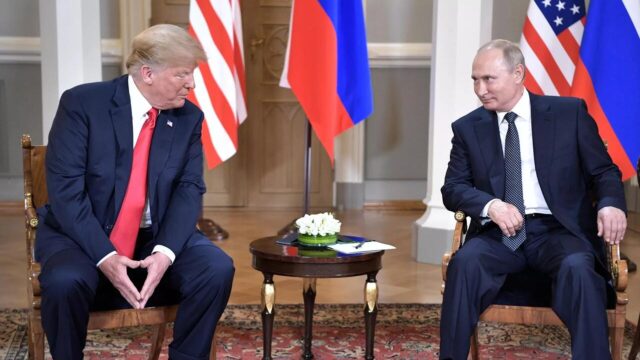Yes, Trump Can End the Russia–Ukraine War

President Donald Trump, after bringing peace to Gaza, is basking in the unexpected diplomatic success and even getting credit from frequent critics. Certainly, the president deserves praise for pressuring Israel’s Prime Minister Benjamin Netanyahu to end the assault on the strip and get back the hostages. But Trump’s approach to a different, unresolved war may deserve even more praise, though political opponents cast it as an abysmal failure.
On the campaign trail, Trump promised to resolve the Russia–Ukraine war within 24 hours of returning to the White House. Clearly, he underestimated the difficulty of settling the conflict, as he himself now routinely concedes. Initially, the president seemed to believe that he, through sheer force of personality, could get Presidents Vladimir Putin and Volodymyr Zelensky to stop fighting. By now, it’s obvious to all that the clashing strategic interests of the belligerents do not allow for easy solutions. Having visited Ukraine last week and experienced first-hand a massive drone-and-missile attack, I can testify to the continued and indeed intensifying horror of the war.
Still, Trump remains Ukraine’s best hope for peace, as I argued last December in Responsible Statecraft. Only the U.S. has the power and political will to engineer a solution to the conflict, and among American politicians, Trump is better than the alternatives. Joe Biden failed to prevent the war (and arguably helped provoke it) and then deferred to second-rate advisors who favored escalating it, even as Mark Milley—America’s highest-ranking general at the time—lobbied hard for negotiations. A Kamala Harris administration, I believe, would have produced little more than saccharine platitudes, more weapons for Ukraine, and a vague hope that Russia will somehow eventually implode.
By contrast, Trump prioritized resolving the war and has proved a man of action and flexibility, deploying carrots and sticks to get both belligerents to make peace. While anti-war conservatives and libertarians lambast Trump for “funding the Ukraine war,” walking away from the conflict would have ended it only in the sense that Russia would have overrun Ukraine much more swiftly—a scenario fraught with political and geopolitical peril. Even worse, the hardline approach advocated by Russia hawks—rejecting outright Moscow’s demands and seeking to bleed Russia dry until it gives up—would have provoked Putin and risked escalation, perhaps to the nuclear level.
Caught between Scylla and Charybdis, Trump has proved a nimble tactician, alternating, as circumstances dictate, between intensifying military support for Ukraine and presenting olive branches to Russia. Now, the administration needs to finalize a coherent strategy and stick to it until the war is concluded. Specifically, the administration should 1) sustain military support for Ukraine to keep alive the possibility of a negotiated settlement, 2) push Kiev to make significant concessions, and 3) offer Moscow a genuine chance for constructive, respectful relations with the West after the war.
At present, Trump is prioritizing the first leg of the multifaceted strategy. Over the weekend he talked to Zelensky about bolstering Ukraine’s air defense and even shipping long-range Tomahawk missiles (though military experts doubt that Kiev has the capability to launch them). This Friday he will host Zelensky in the White House to discuss next steps. In general, these moves make sense. Signaling to Russia that the U.S. won’t allow an imminent Ukrainian collapse is necessary to bring Putin to the negotiating table, and Trump seems mindful that new weapons shipments should be part of an overall diplomatic strategy. (Trump said he might tell Putin, “Look, if this war is not gonna get settled I may send them Tomahawks.”)
Having lived through what felt like a dramatic failure of Ukraine’s air defenses last week, I feel confident that Kiev could use more launchers and interceptors. But U.S. stocks are seriously depleted and Washington can’t send many months’ worth without compromising its own security needs. Trump’s warning about Tomahawks should be interpreted in light of the scarcity of air defense systems; with Ukraine’s shield manifestly cracking, Trump wants to find ways to signal American resolve and keep Putin on his toes. But Trump should be wary of facilitating long-range Ukrainian strikes inside Russia that invite escalatory retaliation and jeopardize any chance of improved U.S. relations with Moscow.
If Trump’s gambit succeeds at nudging Putin toward negotiations, Ukraine—which is losing the war—should be ready to make painful concessions to secure a deal. To that end, Trump should play the role of the bad guy, as he did earlier this year, pushing Zelensky to adopt a concessive negotiating stance that otherwise would be politically too risky for the Ukrainian leader. The rumor in Kiev is that Zelensky would secretly appreciate it.
Fortunately, the biggest concession doesn’t necessarily require Ukraine’s acquiescence. Russia wants a credible commitment that Ukraine won’t be in NATO and that NATO won’t be in Ukraine, and members of the Western alliance should do whatever possible to provide it. If the U.S. and other alliance members—the more the better—formally repudiated previous promises that Ukraine will one day join NATO, that could be a costly enough signal to assuage Moscow’s concerns. Of course, if Ukraine also took steps to forswear its future membership, that would help.
Other disputes, however, will require Ukraine to make some hard choices. One Russian war aim is to “demilitarize” Ukraine, which at present seems to require that Kiev give up offensive military capabilities and maintain a purely defensive posture. Some American analysts, most notably Jennifer Kavanagh of Defense Priorities, have thought hard about what kind and quantity of weapons Ukraine will need to deter Russia from invading again. Using such analyses as a guide, the Trump administration should lobby during negotiations to secure sufficient deterrent capabilities for Ukraine, and it should pressure Kiev to accept caps on weapons that Russia worries could be used against it.
Another sticking point is territory, and in particular the 25 percent or so of the Donetsk province that Russia, despite claiming to annex the entire region in 2022, still hasn’t captured. Putin has offered to freeze the invasion elsewhere if Ukraine voluntarily withdraws forces from Donetsk, but this seems politically impossible for the Zelensky government, which regards the areas it still holds as strategically important and has sacrificed much blood and materiel defending them. Solving this problem won’t be easy, but territorial issues, fortunately, aren’t the primary drivers of the conflict’s continuation.
The Trump administration should, where it makes sense to do so, negotiate contentious issues on separate tracks. Hopefully, after hammering out solutions on the other, more fundamental disputes, both sides will be motivated to find a creative solution for Donetsk rather than let a deal fall through.
Putin’s grip on power is sufficiently secure that he has much political leeway in negotiating a deal. And with Ukraine suffering an acute manpower shortage among infantry units and facing a possible collapse of lines, Zelensky may be willing to give up valuable territory that he’d lose anyway if the war continued. (My read is that Russia isn’t trying to capture territory wherever the opportunity arises, but to attrit Ukrainian forces, which explains why battlefield lines have held fairly steady even as Ukraine’s manpower shortage has grown dire.)
The last prong of the strategy is controversial but unavoidable. Trump needs to somehow convince Putin that, if the war ends in a reasonable settlement, Russia can expect improved relations with the West. Washington cannot expect Moscow to accept vague assurances. Moscow needs to be convinced that it will enjoy sustained and meaningful influence in Europe’s security architecture through instruments like the NATO–Russia Council, which at present is defunct.
Putin began his presidency a quarter of a century ago as an optimistic leader who hoped for better relations with the U.S.-led West. Over time, thanks in large part to Washington’s mismanagement of relations with Russia, he has developed an anti-Western ideology. Given this context, Trump was very wise, early in his second administration, to revive communication with the Kremlin, display respect for Putin, and even put on the table a U.S.–Russia rapprochement. While those moves agitated Russia hawks in Ukraine, Europe, and Washington, they ultimately should help Kiev by giving Moscow a greater incentive to settle the war.
Of course, if Putin’s evolution into a hardline anti-Westerner is complete, then he may see no reason to stop a war that Russia clearly is winning. But Putin, believe it or not, still appears to be a relative moderate within the Russian national security establishment. Above all, he is an opportunist, and he sees in Trump a fleeting opportunity to put relations with America on better footing. Now, Trump needs to convince Russia that reintegration with the American-led West is possible and desirable, even if that first requires ending the Ukraine war.
https://www.theamericanconservative.com/yes-trump-can-end-the-russia-ukraine-war/
